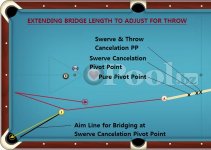Hi Rick,
As far as I know, BHE was something used here and there but not clearly defined other than, line up as usual, then pivot for tip offset. Even accurately measuring pivot points has only been agreed upon in recent years, so the method is evolving. At least my own method is. I'm not familiar with others doing much work on it, though quite a few players use it on some of their preferred shots.
So the squerve pivot point is even a relatively newer concept, that is, where the pivot accounts for both the squirt and the swerve to hit the same point one initially aligns to through CCB.
This is a point where the cue pivots, which I refer to as one's bridge position, though, it could be a finger tip on a rail, or a bridge V for an open bridge or somewhere near the V in a loop bridge.
Where the cue tip strikes the ball is largely inconsequential in my systems. With increased offset, there is increased swerve, but the increased cue angle with offset basically cancels this out. Sounds weird, but it's close to true enough to make BHE as powerful as what it can be.
Swerve also changes for different conditions, hence the bridge length pivot must change. This comes down to a little experience and testing. You'd be surprised how little I actually adjust my bridge length when using it though. Usually my margins for error are large enough to not need to be too precise. On some swervier shots, I do put more thought into my bridge length though.
Although it sounds counter intuitive, it's those high almost parallel hit english shots that swerve earlier than low english shots and present the most difficulties. The overall swerve angle change is less, but it acts earlier, which puts the CB further off line before it reaches the OB.
I have speculated about bridge length adjustments for height of hit before, as seen on Dr. Dave's resource page, but am less convinced of it's necessity now. It doesn't produce as much variability as one might imagine. I do not adjust for it at all any more and it hasn't stopped any continuous improvement and refinement of my use of the system.
The latest concept is including throw compensation into the realm of bridge length compensation and this works well for some shots as I diagrammed a few posts back and in my recent thread on "How to use Pivot Point knowledge to increase error margins (on straightish shots):
http://forums.azbilliards.com/showthread.php?t=405521
I think this area has good potential in making a lot of shots, or basically zones of shots, which introduce throw variation, with exactly the same aim, once one learns the appropriate pivoting length, such that they can hit a wide zone on the CB and still make the shot.
You might want to try out some shots to get clear grasp of how it works. Get your pivot point first, from the tests I outlined in the intro. Then try inside english medium to firm on half ball cuts, aligning as if you were potting with medium firm natural roll. Then pivot to various parts on the CB with inside, from high to low, a touch to extreme inside and there won't be much throw variation. The try the same shot from 5 feet away, but lengthen the bridge about 3 inches to account for the swerve, and you'll find a bridge length for any particular speed at that length that will allow a similar consistency.
Colin
[Added after re-reading your post] - The definition of a squerve, or effective pivot point is that it exactly cancels out both squirt and swerve. This point varies with speed and table conditions of course, but the entire goal is to find the point where it cancels out the swerve, regardless of whether you're hitting 1/8th tip or 1.5 tips left or right of the CCB. In pure physical terms, it's probably not exactly possible, but it is pretty darn close for practical purposes, but further experimentation might provide zones where adjustment is required for different amounts of tip offset, higher and lower as well perhaps. Obviously, with increased elevation, the squerve PP gets longer.

